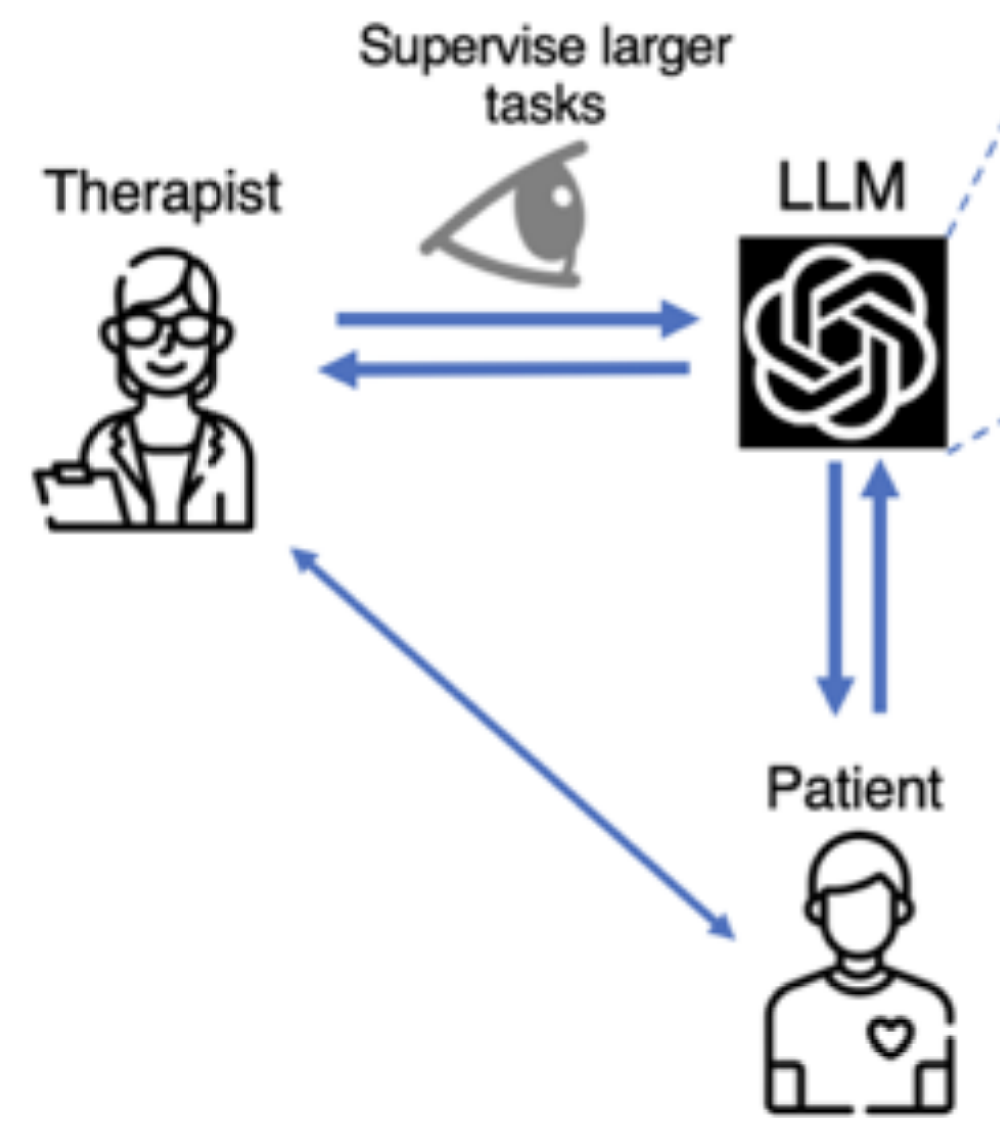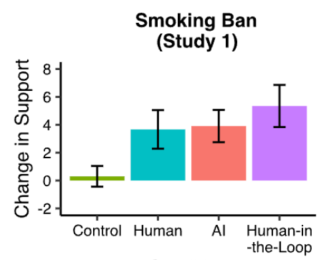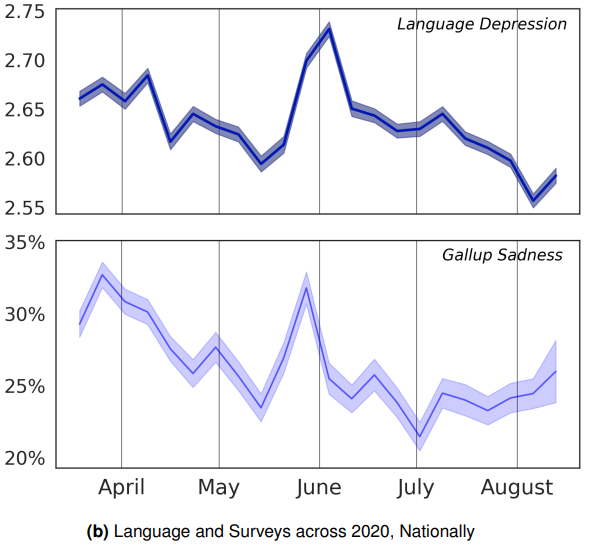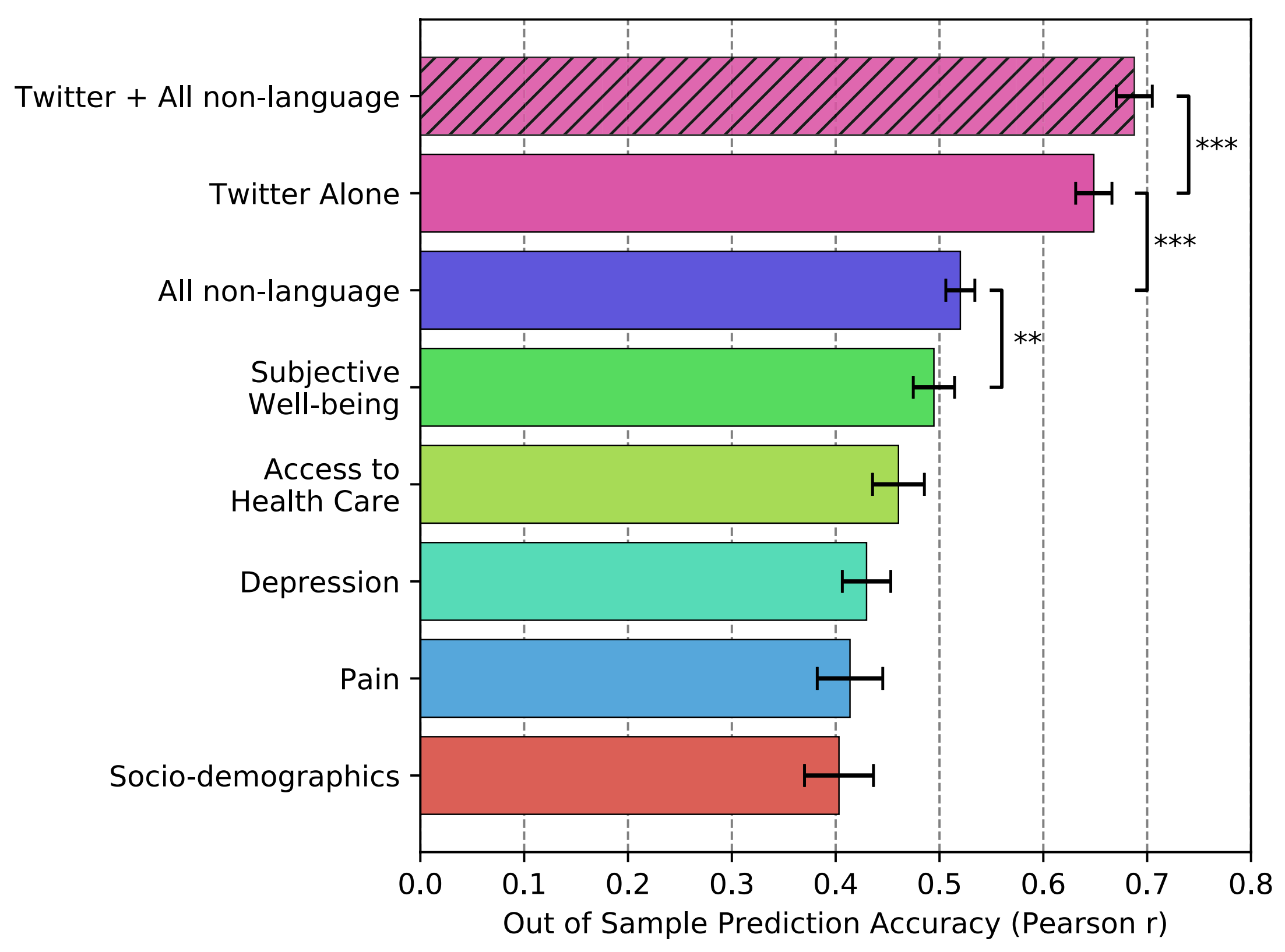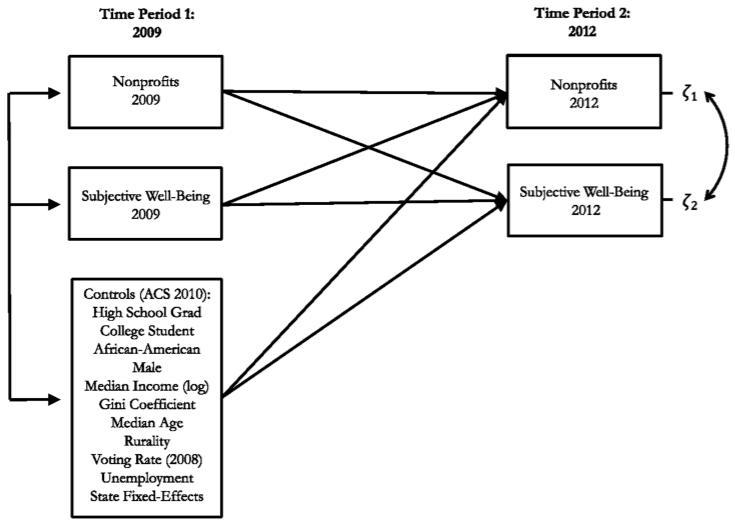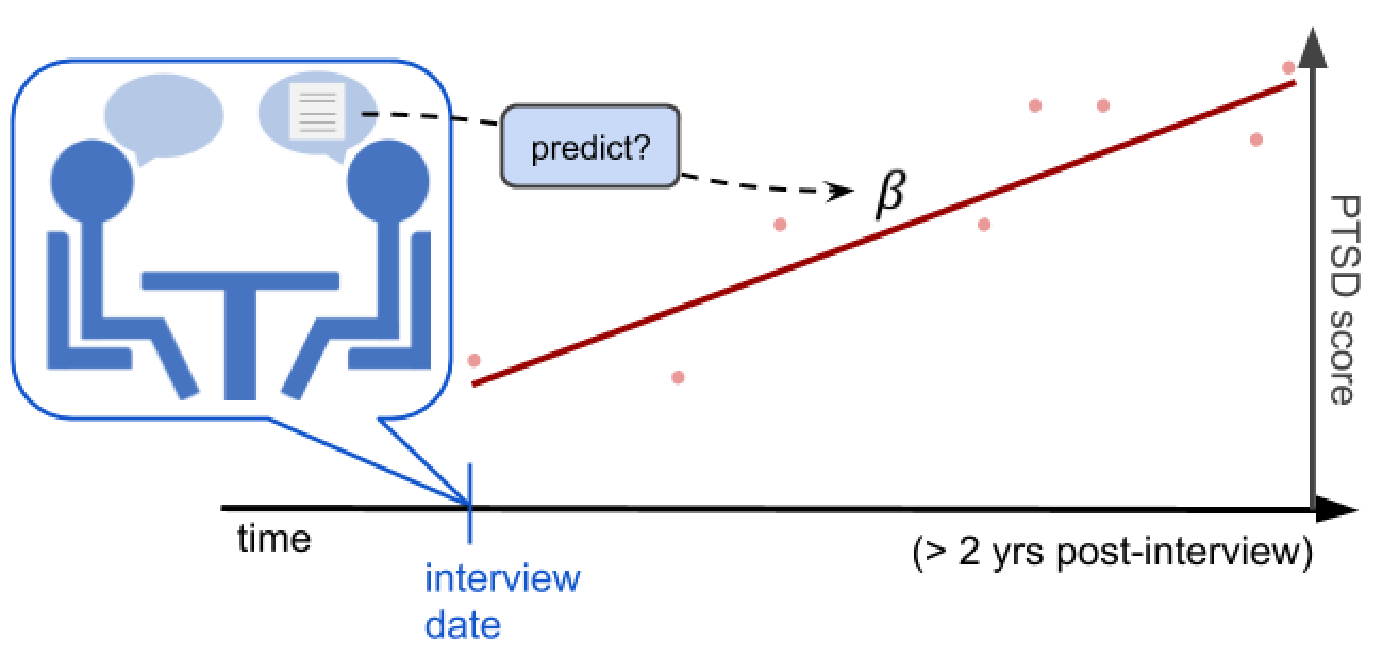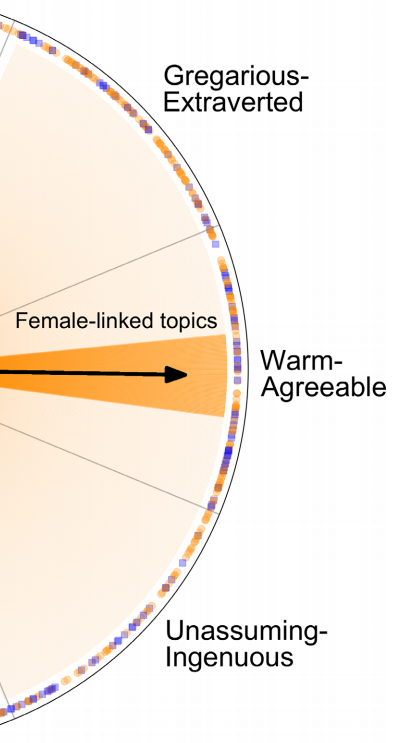I use Large Language Models (LLMs) to develop next-generation therapy, well-being, and health interventions. These developments need to be carefully deployed and evaluated. Lines of work also investigate how LLMs will likely impact society (e.g., political persuasion).
This work is based on a decade of work in computational text analysis to measure and understand individual and population psychology and health. Specifically, I’ve addressed (a) mental and physical health (e.g., depression and heart disease), (b) subjective well-being (e.g., county life satisfaction), and (c) traits & societal phenomena (e.g., personality assessment or impact of Floyd’s death).
These are accompanied by papers that develop and explain the open-vocabulary methods we have pioneered.
See also Google Scholar. I follow open science, open data, and open-source code principles. See github and OSF for all resources. Senior author underlined.
Building Psychological Traits Directly Into LLMs
This is cool work — we used the (observed) statistical association between language and different personality traits to constrain how large language models generate language. In that way, through control tokens, we can “set” them to generate language that conforms to a particular personality, demographic and/or mental health status. This way of controlling generation is completely independent of prompting them and gives another degree of freedom to build LLMs that behave like real people in fine-grained ways.
#2024
[pdf] Vu, H., Nguyen, H. A., Ganesan, A. V., Juhng, S., Kjell, O. N., Sedoc, J., ... & Eichstaedt, J. C. (2024). PsychAdapter: Adapting LLM Transformers to Reflect Traits, Personality and Mental Health. (2024, under review) arXiv preprint arXiv:2412.16882.
Understanding LLMs through a Psychological Lens
We were investigating how to use psychological surveys to capture the “parameter headspace” of large language models. In the process, we found that the more LLMs have been reinforced from human feedback (RLHF, the last step in their “training”), the more they respond to psychology surveys in the ways humans find desirable (higher extraversion and lower neuroticism, etc.).
#2024
[pdf] Salecha, A., Ireland, M. E., Subrahmanya, S., Sedoc, J., Ungar, L. H., & Eichstaedt, J. C. (2024). Large Language Models Show Human-like Social Desirability Biases in Survey Responses. PNAS Nexus.
LLMs Will Transform Psychology & Psychotherapy
Anecdotally, people are already turning to ChatGPT (and friends) for psychological advice. There is a larger unaddressed need in mental health care, and so the temptation is great to “just” deploy LLMs in clinical applications. And the hope is justified — but mental health is an uncommonly high-stakes domains. To deploy LLMs responsible in this space, we have to think in stages, and start with supervised LLMs doing narrow tasks “under supervision.” We are also outlining ways to evaluate such systems to ensure their safety.
#2024
[pdf] Stade, E. C., Eichstaedt, J. C., Kim, J. P., Wiltsey Stirman, S (2024) Readiness Evaluation for AI Deployment and Implementation for Mental Health: A Review and Framework. PsyArxiv Preprint. https://osf.io/preprints/psyarxiv/8zqhw
[pdf] Stade, E. C., Stirman, S. W., Ungar, L. H., Schwartz, H. A., Yaden, D. B., Sedoc, J., … Eichstaedt, J. C. (in press). Artificial intelligence will change the future of psychotherapy: A proposal for responsible, psychologist-led development. npj Mental Health Research. https://doi.org/10.31234/osf.io/cuzvr
[pdf] Demszky, D., Yang, D., Yeager, D. S., Bryan, C. J., Clapper, M., Chandhok, S., Eichstaedt, J. C. ... & Pennebaker, J. W. (2023). Using large language models in psychology. Nature Reviews Psychology, 1-14.
Using NLP to Understand Problem-Solving Negotiations Between Israelis and Palestinians
We are developing a line of work analyzing the text of previously confidential mediation workshops with Israelis and Palestinians and examining what psychological processes and linguistic patterns predict positive negotiation outcomes. The first paper reports an analysis of a 1999 workshop. This work is led by Oliver Fink.
#2024
[pdf] Fink, O., Graf, W., Subrahmanya, S., Salecha, A., & Eichstaedt, J.C. (2024, in print). The Language of Conflict Transformation: Assessing Psychological Change Patterns in Israeli-Palestinian Track Two Interactive Problem Solving. Negotiation and Conflict Management Research.
Exploring how AI and Large Language Models Interact with Humans
#2023
[pdf] Bai, H., Voelkel, J. G., Eichstaedt, J. C., & Willer, R. (2023, February 5). Artificial Intelligence Can Persuade Humans on Political Issues. https://doi.org/10.31219/osf.io/stakv
Comparing Well-Being across Cultures
We investigate the popular belief that Denmark and co. “are the happiest” to show that this is only narrowly true for life satisfaction and that other parts of the world lead in positive emotions (Central America!).
#2024
[pdf] Nilsson, A.H., Kopperud, K., Kjell, O., Bang Nes, R., Martela, F., Pentikäinen, V., Lomas, T., Lahti, E. & Eichstaedt, J. C. (2024, under review). Nordic Countries Lead in Life Evaluation but Not Emotional Well-Being. PsyArxiv: https://osf.io/preprints/psyarxiv/76e2h
Measuring County Mental Health with Social Media + AI
This is the culmination of many years of work. We validate a pipeline that uses a sample of 1.2 billion Tweets from 2 million geo-located users to estimate mental health changes for depression and anxiety across counties.
#2024
[pdf] Mangalik, S., Eichstaedt, J. C., Giorgi, S., Mun, J., Ahmed, F., Gill, G., ... & Schwartz, H. A. (2024). Robust language-based mental health assessments in time and space through social media. njp Digital Medicine. 7, 109 (2024)
Monitoring the Opioid Epidemic through Social Media
Our communities continue to suffer from the opioid epidemic, with as many as 100k deaths/year in 2021, which is 2.5x car crashes, and 2x gun-related injuries. Digital traces on Twitter, Reddit, and other social media sites may present an avenue to monitor which communities are most at risk, and how scarce overdose medications could be best distributed.
First results suggest that it can be done and that it’s non-specific markers of community despair that explain most of the predictive signal for counties on Twitter.
This work is supported by an R21 by the National Institute on Drug Abuse (NIDA).
#2024
[pdf] Carpenter, K. A., Nguyen, A. T., Smith, D. A., Samori, I. A., Humphreys, K., Lembke, A., Kiang, M. V., Eichstaedt, J. C.* & Altman, R. B.* (2024). Which Social Media Platforms Provide the Most Informative Data for Monitoring the Opioid Crisis? medRxiv, 2024-07.
*same contribution
#2023
[pdf] Giorgi, S., Yaden, D. B., Eichstaedt, J. C., Ungar, L. H., Schwartz, H. A., Kwarteng, A., & Curtis, B. (2023). Predicting US county opioid poisoning mortality from multi-modal social media and psychological self-report data. Scientific Reports, 13(1), 9027.
Understanding the Importance of Belonging Beliefs in the College Transition
We use NLP to track beliefs about belonging in a large field experiment, and show that disadvantaged groups are more likely to doubt if somebody like them belongs. Belonging interventions can change these beliefs for all.
#2024
[pdf] Demszky, D., Lee Williams, C., Brady, S., Subrahmanya, S., Gaudiello, E., Walton, G. M, & Eichstaedt, J. C. (2024, under review). Computational Language Analysis Reveals that Process-Oriented Thinking About Belonging Aids the College Transition.
Understanding What Well-Being Surveys Implicitly Measure
Standard well-being surveys foreground relative standing in society and in the income distribution, rather than broader well-being (health, relationships, etc.). That may make them problematic ways to measure societal progress and explain why, on average, well-being has been flat while GDP has been improving. NLP and AI methods helped us figure this out.
#2024
[pdf] Nilsson, A.H., Eichstaedt, J. C., Lomas, T. & Kjell, O. (2024) The Cantril Ladder elicits thoughts about power and wealth. Scientific Reports 14, 2642 (2024).
Measuring Community Well-Being through Digital Traces
We use Twitter and Facebook to assess county and person-level life satisfaction and well-being, using well-being data collected through surveys to train our models. It can be done, particularly if one adds socioeconomic information to the prediction models. The language most associated with life satisfaction looks roughly like one would expect based on the well-being literature, reflecting higher income and better jobs but also more time spent doing fun and healthy things.
When measuring well-being using Twitter, it is important how Tweets are aggregated: measuring communities as groups of users (within whom the tweets are nested) notably improves out-of-sample prediction accuracies (when validated against Gallup surveys). This even allows for demographic post-stratification to balance representation biases in the Twitter sample (see the World Happiness Report chapter for a review).
See our Twitter-based county-level map of well-being here.
#2024
Giorgi, S., Jones, J. J., Buffone, A., Eichstaedt, J. C., Crutchley, P., Yaden, D. B., ... & Schwartz, H. A. (2024). Quantifying generalized trust in individuals and counties using language. Frontiers in Social Psychology, 2, 1384262. [pdf]
#2023
[pdf] Giorgi, S., Eichstaedt, J. C., Preotiuc-Pietro, D., Gardner, J. R., Schwartz, H. A., & Ungar, L. H. (2023). Filling in the white space: Spatial interpolation with Gaussian processes and social media data. Current research in ecological and social psychology, 5, 100159.
[pdf] Kjell, O., Giorgi, S., Schwartz, H. A. & Eichstaedt, J.C. (2023) Towards Well-Being Measurement with Social Media Across Space, Time and Cultures: Three Generations of Progress. In the 2023 World Happiness Report, Chapter 5.
#2021
[pdf] Giorgi, S., Nguyen, K. L., Eichstaedt, J. C., Kern, M. L., Yaden, D. B., Kosinski, M., Seligman, M. E. P., Ungar, L. H., Schwartz, H. A. & Park, G. (2021, print). Regional personality assessment through social media language. Journal of Personality.
[pdf] Giorgi, S., G. Guntuku, S. C., Eichstaedt, J. C., Pajot, C., Schwartz, A. H., & Ungar, L. H. (2021) "Well-Being Depends on Social Comparison: Hierarchical Models of Twitter Language Suggest That Richer Neighbors Make You Less Happy." International AAAI Conference on Weblogs and Social Media (ICWSM).
#2020
[pdf] Jaidka, K., Giorgi, S., Schwartz, H. A., Kern, M. L., Ungar, L. H., & Eichstaedt, J. C. (2020). Estimating geographic subjective well-being from Twitter: A comparison of dictionary and data-driven language methods. Proceedings of the National Academy of Sciences, 117(19), 10165-10171.
[OSF: Data and code] [Supplement]
#2018
[pdf] Otto, A. R., & Eichstaedt, J. C. (2018). Real-world unexpected outcomes predict city-level mood states and risk-taking behavior. PloS one, 13(11), e0206923.
[pdf] Obschonka, M., Lee, N., Rodríguez-Pose, A., Eichstaedt, J. C., & Ebert, T. (2018). Big Data, artificial intelligence and the geography of entrepreneurship in the United States. Centre for Economic Policy Research.
#2016
[pdf] Smith, L.K., Giorgi, S., Solanki, R., Eichstaedt, J. C., Schwartz, A. H., Abdul-Mageed, M., Buffone, A., & Ungar, L. H. (2016). Does 'well-being translate on Twitter?' Proceedings of the 2016 Conference on Empirical Methods in Natural Language Processing (EMNLP)
#2013
[pdf] Schwartz, H. A.*, Eichstaedt, J. C. *, Kern, M. L., Dziurzynski, L., Lucas, R. E., Agrawal, M., Park, G. J., Lakshmikanth, S. K., Jha, S., Seligman, M. E. P., & Ungar, L. H. (2013). Characterizing Geographic Variation in Well-Being using Tweets. In Seventh International AAAI Conference on Weblogs and Social Media (ICWSM). Boston, MA. (* Equal contribution.)
Press: The Atlantic Blog
Comparing Indices of Area-Based Disadvantage
We compared 5 U.S. disadvantage indices at the county level on their relationships to 24 life outcomes related to mortality, physical health, mental health, subjective well-being, and social capital.
#2023
[pdf] Lou, S., Giorgi, Sl. Liu, T.., Eichstaedt, J. C. & Curtis, B. (2023). Measuring disadvantage: A systematic comparison of United States small-area disadvantage indices. Health & Place, Vol 80, 102997.
Measuring Self-Reported Depression & Anxiety Through Social Media
Across a variety of studies, we are trying to understand how depression manifests behaviorally in people’s lives through analysis of text entered on phone keyboards and shared on social media.
#2023
[pdf] Juhng, S., Matero, M., Varadarajan, V., Eichstaedt, J. C., Ganesan, A. V., & Schwartz, H. A. (2023, July). Discourse-Level Representations can Improve Prediction of Degree of Anxiety. In Proceedings of the 61st Annual Meeting of the Association for Computational Linguistics (ACL) (pp. 1500-1511).
[pdf] Liu, T., Jain, D., Rapole, S. R., Curtis, B., Eichstaedt, J. C., Ungar, L. H. & Guntuku, S. C. (2023). Detecting Symptoms of Depression on Reddit. WebSci 2023 (April 2023)
#2022
[pdf] Liu, T., Ungar, L. H., Curtis, B., Sherman, G., Yadeta, K., Tay, L., Eichstaedt, J. C. & Guntuku, S. C. (2022). Head versus heart: social media reveals differential language of loneliness from depression. npj Mental Health Research, 1(1), 1-8.
#2021
[pdf] Liu, T., Meyerhoff, J., Eichstaedt, J. C., Karr, C. J., Kaiser, S. M., Kording, K. P., ... & Ungar, L. H. (2021). The relationship between text message sentiment and self-reported depression. Journal of Affective Disorders.
#2019
[pdf] Guntuku, S. C., Preotiuc-Pietro, D., Eichstaedt, J. C. & Ungar, L. H. (2019). What Twitter Profile and Posted Images Reveal about Depression and Anxiety. In Thirteenth International AAAI Conference on Web and Social Media (ICWSM).
#2017
[pdf] Guntuku, S. C., Yaden, D. B., Kern, M. L., Ungar, L. H., & Eichstaedt, J. C. (2017). Detecting depression and mental illness on social media: an integrative review. Current Opinion in Behavioral Sciences, 18, 43-49.
We review the state-of-the-art of depression prediction from social media text. I can be done (AUCs reach .70, so minimal diagnostic validity) but so far the literature has been based entirely on self-reported depression status, not clinical diagnoses.
# 2015
[pdf] Preotiuc-Pietro, D., Eichstaedt, J.C., Park, G., Sap, M., Smith, L., Tobolsky, V., Schwartz, H. A., & Ungar, L. H. (2015). The Role of Personality, Age and Gender in Tweeting about Mental Illnesses. Proceedings of the Workshop on Computational Linguistics and Clinical Psychology: From Linguistic Signal to Clinical Reality, NAACL.
# 2014
[pdf] Schwartz, H. A., Eichstaedt, J. C., Kern, M. L., Park, G., Sap, M., Stillwell, D., Kosinski, M., Ungar, L. H. (2014). Towards Assessing Changes in Degree of Depression through Facebook. ACL 2014 Workshop on Computational Linguistics and Clinical Psychology, 118.
Creating More Civil Online Environments with Less Misinfo
We show that US politicians have become more incivil on Twitter since 2009, even after factoring out Trump. Too much attention paid to like and retweet metrics may be to blame.
#2023
[pdf] Wilhelm, E., (…), Eichstaedt J.C., (…), Purnat, T. D. (2023) Measuring the Burden of Infodemics: Summary of the Methods and Results of the Fifth WHO Infodemic Management Conference. JMIR Infodemiology 2023;3:e44207 doi: 10.2196/44207
#2022
[pdf] Frimer, J. A., Aujla, H., Feinberg, M., Skitka, L. J., Aquino, K., Eichstaedt, J. C., & Willer, R. (2022). Incivility is rising among American politicians on Twitter. Social Psychological and Personality Science, 19485506221083811.
Predicting Future Clinical Diagnoses of Depression and Illness Through Facebook
We are trying to better understand the manifestation of mental illness in social media language, and how to use the social media to predict it--even ahead of its first documentation in the medical record.
#2019
[pdf] Merchant, R. M., Asch, D. A., Crutchley, P., Ungar, L. H., Guntuku, S. C., Eichstaedt, J. C., ... & Schwartz, H. A. (2019). Evaluating the predictability of medical conditions from social media posts. PloS one, 14(6), e0215476.
#2018
[pdf] Eichstaedt, J. C.*, Smith, R. J.*, Merchant, R. M., Ungar, L. H., Crutchley, P., Daniel Preotiuc-Pietro, D., Asch, D. A., & Schwartz, H. A. (2018) Facebook language predicts depression in medical records. Proceedings of the National Academy of Sciences., 115 (44), 11203-11208. (* Equal contribution.)
We show that the Facebook posts of patients in a large academic health system allow for the prediction of a future diagnosis of depression up to three months in advance. The heroic data collection effort in which over 11,000 patients were individually approached and consented has been described here.
Impact: Coverage by 50+ international press outlets, see full media coverage here.
They include: New York Times, WIRED, Fox News, CBS News, New York Post & Der Spiegel.
This article reached the 99th percentile of media attention across all research outputs tracked by Altmetric.
Racial Justice & the Impact of George Floyd’s Death
When George Floyd was killed, anger and sadness rose to unprecedented levels in the population, far beyond the elevated post-COVID-19 baselines. Depression and anxiety symptoms spiked as well, particularly for Black Americans.
#2021
[pdf] Eichstaedt, J. C., Sherman, G. T., Giorgi, S., Roberts, S. O., Reynolds, M. E., Ungar, L. H., & Guntuku, S. C. (2021). The emotional and mental health impact of the murder of George Floyd on the US population. Proceedings of the National Academy of Sciences of the United States of America, 118(39), e2109139118.
Tracking the COVID-19 Response with Twitter
We have a number of lines of work to track and explain social distancing and adherence to public health guidelines with Twitter and to track the impact of COVID on population mental health and subjective well-being.
#2022
[pdf] Levanti. D., Monastero, R. N., Zamani, M., Eichstaedt, J. C., Giorgi, S., Schwartz, H. A., & Meliker, J.R., (2022, in press). Depression and anxiety on Twitter during the COVID-19 stay-at-home period in seven major US cities, AJPM Focus, doi: https://doi.org/10.1016/j.focus.2022.100062
#2020
[pdf] Zamani, M., Schwartz, H. A., Eichstaedt, J. C., Guntuku, S. C., Ganesan, A. V., Clouston, S., & Giorgi, S. (2020, November). Understanding Weekly COVID-19 Concerns through Dynamic Content-Specific LDA Topic Modeling. In Proceedings of the Fourth Workshop on Natural Language Processing and Computational Social Science (pp. 193-198).
[pdf] van Loon, A., Stewart, S., Waldon, B., Lakshmikanth, S. K., Shah, I., Zou, J., & Eichstaedt, J. C. (2020). Explaining the ‘Trump Gap’ in Social Distancing Using COVID discourse. In proceedings of EMNLP 2020 (Empirical Methods in NLP) workshop on COVID-19.
[pdf] Santosh, R., Schwartz, H. A., Eichstaedt, J. C., Ungar, L., & Guntuku, S. C. Detecting Emerging Symptoms of COVID-19 using Context-based Twitter Embeddings. In proceedings of EMNLP 2020 (Empirical Methods in NLP) workshop on COVID-19.
Unhappiness Predicted Voting for Trump
County-level analyses of Gallup surveys reveal that (low) subjective well-being in the 8 years preceeding the Trump election predict the Trump vote over and above the usual vote for Republicans. Expected life satisfaction emerges as the strongest predictor at r = .78 across 3,000+ counties -- an effect size rarely seen in the social sciences.
We think the link between unhappiness and voting is particularly strong for populists -- like Trump and Sanders.
#2020
[pdf] Ward, G., De Neve, J.-E., Ungar, L. H., & Eichstaedt, J. C. (2020, July 23). (Un)Happiness and Voting in U.S. Presidential Elections. Journal of Personality and Social Psychology. Advance online publication. http://dx.doi.org/10.1037/pspi0000249
Here is a general audience summary.
Story in the Financial Times.
Public Policy Applications of Big Social Data
Natural language processing for mental health monitoring is an emerging use of AI that is poised to disrupt the landscape of the health care industry. Social media platforms allow the population to share their thoughts and feelings with the world — users’ posts allow for medical screening for disorders such as depression.
Users are already being marketed to with sophistication based on these behaviors — why not leverage these technologies for public health?
#2021
[pdf] Ressler, R. W., Paxton, P., Velasco, K., Pivnick, L., Weiss, I., & Eichstaedt, J. C. (2021). Nonprofits: A public policy tool for the promotion of community subjective well-being. Journal of Public Administration Research and Theory, 31(4), 822-838.
Policy Brief: Tracking Mental Health through Social Media
[pdf] AI-Enabled Depression Prediction Using Social Media (2021). Eichstaedt, J. C. Policy Brief Series, Institute for Human-Centered AI, Stanford, CA.
And a related write-up for the Brookings Institute.
Public Health Applications of Big Social Data
#2020
[pdf] Jaidka, K., Eichstaedt, J. C., Giorgi, S., Schwartz, H. A., Efron, N., & Ungar, L. H. (2020). Information-seeking vs. sharing: Which explains regional health? An analysis of Google Search and Twitter trends. Telematics and Informatics, 101540.
[pdf] Giorgi, S., Yaden, D. B., Eichstaedt, J. C., Ashford, R. D., Buffone, A .E., Schwartz, H. A., Ungar, L. H., Curtis, B. (2020) Cultural Differences in Tweeting about Drinking Across the US. International Journal of Environmental Research and Public Health. 17, 1125.
We examine how Tweeting drinking keywords dovetails with CDC-survey-determined excessive drinking rates across different community types in the U.S.
Understanding Individual Life Choices & Well-Being
Striking findings about the importance of different life choices on different types of well-being, and strong signal for a midlife crisis. If you have to choose between money and health, always choose health.
#2024
[pdf] Bianchi, E, Correa M., Eichstaedt, J.C., & Billington, S.L. (2024) Nature, buildings, and humans: Residents’ perceptions of well-being in permanent supportive housing. Environment and Behavior.
[pdf] Matero, M., Vu, H., Nilsson, A., Mahwish, S., Cho, Y.M., McKay, J., Eichstaedt, J. C., Rosenthal, R., Ungar, L. and Schwartz, H.A. (2024, March). Using Daily Language to Understand Drinking: Multi-Level Longitudinal Differential Language Analysis. In Proceedings of the 9th Workshop on Computational Linguistics and Clinical Psychology (CLPsych 2024) (pp. 133-144).
#2023
[pdf] Sametoglu, S., Pelt, D., Eichstaedt, J. C., Ungar, L. H., & Bartels, M. (2023). Comparison of wellbeing networks based on survey responses and social media language. Applied Psychology: Health and Well-Being. https://doi.org/10.1111/aphw.12451
[pdf] Sametoğlu, S., Pelt, D. H. M., Eichstaedt, J. C., Ungar, L. H., & Bartels, M. (2023). The value of social media language for the assessment of wellbeing: a systematic review and meta-analysis. The Journal of Positive Psychology, 1-19.
#2020
[pdf] Eichstaedt, J. C., Yaden, D. B ., Ribeiro, F., Adler, A., & Kern , M. L . (2020). Lifestyle and wellbeing: Exploring behavioral and demographic covariates in a large US sample. International Journal of Wellbeing , 10 (4), 87 - 112 . https://doi.org/ 10.5502/ijw.v10i4.831
#2016
[pdf] Schwartz, H. A., Sap, M., Kern, M. L., Eichstaedt, J. C., Kapelner, A., Agrawal, M., Blanco, E., Dziurzynski, L., Park, G., Stillwell, D., Kosinski, D., Seligman, M.E.P., Ungar, L.H. (2016). Predicting Individual Well-Being Through the Language of Social Media. Pacific Symposium on Biocomputing 21:516-527.
Tracking Emotional Trajectories Within Persons
We’ve done a lot of work measuring traits with social media — in this work we turn to states. We leverage the big data methods to compute week-by-week affect estimates for 640 users who have posted a lot on Facebook (20,000+ words!). The density of the data allows us to track emotional trajectories across many months, and animate affect over many months.
#2020
[pdf] Eichstaedt, J. C. & Weidman, A. (2020, in press) Tracking Fluctuations in Psychological States: A Case Study of Weekly Emotion Using Social Media Language. European Journal of Personality.
640 Animations, and all data & code are on OSF. Example Animation 1, 2.
Text Analysis Methods in Psychology
These two papers make a good self-contained introduction to working with NLP in the social sciences. The 2020 paper is intended as a comprehensive general introduction and bake-off.
These papers are the basis of this NLP and ML in the Social Sciences course at Stanford.
# 2021
[pdf] Eichstaedt, J. C., Kern, M. L., Yaden, D. B., Schwartz, H. A., Giorgi, S., Park, G., Hagan, C.A., Tobolsky, V., Smith, L. K., Buffone, A., Iwry, J., Seligman, M. E. P., & Ungar, L. H.; (2021). Closed and Open Vocabulary Approaches to Text Analysis: A Review, Quantitative Comparison, and Recommendations. Psychological Methods, 26(4), 398.
[Lots of supplemental materials are here]
# 2016
[pdf] Kern, M. L., Park, G., Eichstaedt, J. C., Schwartz, H. A., Sap, M., Smith, L. K., & Ungar, L. H. (2016). Gaining Insights From Social Media Language: Methodologies and Challenges. Psychological Methods.
A general introduction to how to carry out analyses with DLATK.
Text Analysis Methods in Natural Language Processing
Many social scientists (including us) use relatively simple "word count" methods to measure psychological variables. Machine-learning and NLP-based methods can improve on these approaches, sometimes modestly, sometimes dramatically.
#2022
[pdf] van Loon, A., Giorgi, S., Willer, R., & Eichstaedt, J. C. (2022, May). Negative Associations in Word Embeddings Predict Anti-black Bias across Regions–but Only via Name Frequency. In Proceedings of the International AAAI Conference on Web and Social Media (Vol. 16, pp. 1419-1424).
#2017
[pdf] Schwartz, H. A., Giorgi, S., Sap, M., Crutchley, P., Eichstaedt, J. C., & Ungar, L., H.(2017). DLATK: Differential language analysis ToolKit. In Proceedings of the 2017 Conference on Empirical Methods in Natural Language Processing: System Demonstrations (pp. 55-60).
Our entire code-base has been released open source, thanks to a heroic effort by Andy Schwartz and Sal Giorgi. See dlatk.wwbp.org. Now even in docker containers!
# 2016
[pdf] Preotiuc-Pietro, D., Schwartz, H.A., Park, G., Eichstaedt, J. C., Kern, M., Ungar, L., Shulman, E.P. (2016). Modelling Valence and Arousal in Facebook Posts. Proceedings of the Workshop on Computational Approaches to Subjectivity, Sentiment and Social Media Analysis (WASSA), NAACL.
# 2014
[pdf] Sap, M., Park, G., Eichstaedt, J. C., Kern, M. L., Stillwell, D. J., Kosinski, M., Ungar, L. H., & Schwartz, H. A. (2014). Developing age and gender predictive lexica over social media. Conference on Empirical Methods in Natural Language Processing (EMLNP). Doha, Qatar.
# 2013
[pdf] Schwartz, H. A., Eichstaedt, J. C., Dziurzynski, L., Kern, M. L., Blanco, E., Ramones, S., Seligman, M. E. P., & Ungar, L. H. (2013). Choosing the Right Words: Characterizing and Reducing Error of the Word Count Approach. In *SEM-2013: Second Joint Conference on Lexical and Computational Semantics.
The Impact of Technology on Societies
#2020
[pdf] Ahmed, S., Cho, J., Jaidka, K., Eichstaedt, J. C., & Ungar, L. H. (2020). The Internet and Participation Inequality: A Multilevel Examination of 108 Countries. International Journal of Communication, 14, 22.
#2018
[pdf] Yaden, D. B., Eichstaedt, J. C., & Medaglia, J. D. (2018). The Future of Technology in Positive Psychology: Methodological Advances in the Science of Well-Being. Frontiers in psychology, 9, 962.
Predicting Recovery from Trauma from Oral Histories of 9/11 First Responders
# 2020
[pdf] Son, Y., Clouston, S., Kotov, R., Eichstaedt, J. C., Bromet, E. J., Luft, B. J., & Schwartz, H. A. (2021). World Trade Center responders in their own words: predicting PTSD symptom trajectories with AI-based language analyses of interviews. Psychological medicine, 1–9.
Twitter Predicts Community Heart Disease
We show that Twitter can capture more information about county-level atherosclerotic heart disease than solid epidemiological models that include socioeconomic status, demographics and health variables, like smoking, diabetes and hypertension. Hostility and disengagement in particular are associated with risk. Engagement, positive emotions and optimism show protective associations.
# 2018
[pdf] Eichstaedt, J. C., Schwartz, H. A., Giorgi, S., Kern, M. L., Park, G., Sap, M., Labarthe D.R., Larson, E. E., Seligman, M. E, P., & Ungar, L. H. (2018, March 15). More Evidence that Twitter Language Predicts Heart Disease: A Response and Replication. PsyArXiv. https://doi.org/10.31234/osf.io/p75ku
# 2015
** [pdf] Eichstaedt, J. C., Schwartz, H. A., Kern, M. L., Park, G., Labarthe, D. R., Merchant, R. M., Jha, S., Agrawal, M., Dziurzynski, L. A., Sap, M., Weeg, C., Larson, E. E., Ungar, L. H., & Seligman, M. E. (2015). Psychological Language on Twitter Predicts County-Level Heart Disease Mortality. Psychological Science.
[pdf] - [big pdf with supplement] - [OPEN DATA]
See here for a tutorial on how to load and work with the associated data set.
Impact: Coverage by 50+ international media outlets (see full media coverage here and here).
They include the Washington Post, The New Yorker, and, importantly, The Onion.
This article reached the 99th percentile of media attention across all research outputs tracked by Altmetric.
Positive Traits: Character Strengths, Empathy & Locus of Control
We have used Facebook, Twitter and medical school admission essays to study locus of control, different kinds of empathy and character strengths.
#2023
[pdf] Yaden, D. B., Giorgi, S., Jordan, M., Buffone, A., Eichstaedt, J. C., Schwartz, H. A., Ungar, L. H. & Bloom, P. (2023). Characterizing empathy and compassion using computational linguistic analysis. Emotion.
#2022
[pdf] Omitaomu, D., Tafreshi, S., Liu, T., Buechel, S., Callison-Burch, C., Eichstaedt, J. C., Ungar, L. H. & Sedoc, J. (2022). Empathic Conversations: A Multi-level Dataset of Contextualized Conversations. arXiv preprint arXiv:2205.12698.
#2020
[pdf] Yaden, M. E., Yaden, D. B., Buffone, A. E. K., Eichstaedt, J. C., Crutchley, P., Smith, L., Cass, J. L., Callahan, C. A., Rosenthal, S., R., Ungar, L. H.,, Schwartz, H. A., Hojat, M. (2020, in press) Linguistic Analysis of Empathy in Medical School Admission Essays. International Journal of Medical Education.
#2019
[pdf] Pang, D., Eichstaedt, J. C., Buffone, A., Slaff, B., Ruch, W., & Ungar, L. H. (In press). The Language of Character Strengths: Predicting Morally Valued Traits on Social Media. Journal of Personality.
#2017
[pdf] [poster] Jaidka, K., Buffone, A., Giorgi, S., Eichstaedt, J. C., Rouhizadeh, M., & Ungar, L. H. (2018). Modeling and visualizing locus of control with Facebook language. Proceedings of the International AAAI Conference on Web and Social Media (ICWSM).
[pdf] Abdul-Mageed, M., Buffone, A., Peng, H., Eichstaedt, J. C., & Ungar, L. H. (2017). Recognizing Pathogenic Empathy in Social Media. In Proceedings of the Twelfth International AAAI Conference on Web and Social Media (ICWSM). pp. 448-451.
Psychological Traits: Temporal Orientation & Stress
# 2019
[pdf] Guntuku, S. C., Buffone, A., Jaidka, K., Eichstaedt, J.C., & Ungar, L. (2019). Understanding and Measuring Psychological Stress using Social Media. In International AAAI Conference on Web and Social Media (ICWSM). Vol. 13, pp. 214-225.
# 2015
[pdf] Park, G., Schwartz, H. A., Sap, M., Kern, M. L., Weingarten, E., Eichstaedt, J. C., Berger, J., Stillwell, D. J., Kosinski, M., Ungar, L. H. & Seligman, M. E. (2015). Living in the Past, Present, and Future: Measuring Temporal Orientation with Language. Journal of Personality.
[pdf] Schwartz, H. A., Park, G., Sap, M., Weingarten, E., Eichstaedt, J.C., Kern, M., Stillwell, D., Kosinski, M., Berger, J., Seligman, M., & Ungar, L. (2015). Extracting Human Temporal Orientation from Facebook Language. NAACL-2015: Conference of the North American Chapter of the Association for Computational Linguistics.
Measuring Personality through Facebook better than Friends
We show that Facebook-language-based predictions of personality are about as good as a friend's rating.
# 2014
** [pdf] Park, G., Schwartz, H. A., Eichstaedt, J. C., Kern, M. L., Kosinski, M., Stillwell, D. J., Ungar, L. H., & Seligman, M. E. P. (2014). Automatic personality assessment through social media language. Journal of Personality and Social Psychology, 108(6), 934
Press: neuroskeptic, New York Magazine
Measuring Personality, Gender & Age with Digital Traces
We identified the word, phrases and topics most correlated with gender, different age ranges, dimensions of personality, temporal orientation and locus of control across 75,000 users. Turns out this a great tool to understand the thoughts and behaviors that characterize personality, and different stages of life.
# 2016
[pdf] Park, G., Yaden, D. B., Schwartz, H. A., Kern, M. L., Eichstaedt, J. C., Kosinski, M., ... & Seligman, M. E. (2016). Women are Warmer but No Less Assertive than Men: Gender and Language on Facebook. PloS ONE, 11(5), e0155885.
Placing gender language topics in the emotional circumplex. Neat figures.
Press: Press Release, New York Times,
# 2014
[pdf] Kern, M. L., Eichstaedt, J. C., Schwartz, H. A., Dziurzynski, L., Ungar, L. H., Stillwell, D. J., … & Seligman, M. E. P. (2014). The online social self: An open vocabulary approach to personality. Assessment, 21, 158-169.
[pdf] Kern, M. L., Eichstaedt, J. C., Schwartz, H. A., Park, G., Ungar, L. H., Stillwell, D. J., … & Seligman, M. E. P. (2014). From “sooo excited!!!” to “so proud”: Using language to study development. Developmental Psychology, 50, 178-188
# 2013
** [pdf] Schwartz, H. A., Eichstaedt, J. C., Kern, M. L., Dziurzynski, L., Ramones, S. M., Agrawal, M., Shah, A., Kosinki, M., Stillwell, D., Seligman, M. E. P., & Ungar, L. H. (2013). Personality, gender, and age in the language of social media: The open-vocabulary approach. PLOS ONE, 8, e73791. online
[pdf] Schwartz, H. A., Eichstaedt, J. C., Dziurzynski, L., Kern, M. L., Blanco, E., Kosinski, M., Stillwell, D., Seligman, M. E. P., & Ungar, L. H. (2013). Toward Personality Insights from Language Exploration in Social Media. In AAAI Spring Symposium Series. Stanford, CA.
Press: Press release, Wired, Slate, New York Times Blog, Psychologie Heute, Business Insider, Daily Mail, MIT Technology Review, USA Today, terrible
The Psychology of Spiritual Experiences
In a number of projects, we are characterizing self-transcendent, spiritual, and mystical experiences. Important take-aways include the transformative character of self-transcendent experiences and the multi-faceted nature of these experiences (see the 2021 paper).
# 2021
[pdf] Yaden, D. B., Giorgi, S., Kern, M. L., Adler, A., Ungar, L. H., Seligman, M. E. P., & Eichstaedt, J. C. (2021). Beyond beliefs: Multidimensional Aspects of Religion and Spirituality in Language. Psychology of Religion and Spirituality.
# 2017
[pdf] Yaden, D. B., Eichstaedt, J. C., Kern, M. L., Smith, L. K., Buffone, A., Stillwell, D. J., Kosinski, M., Ungar, L.H., Seligman, M.E. & Schwartz, H. A. (2017). The Language of Religious Affiliation: Social, Emotional, and Cognitive Differences. Social Psychological and Personality Science, 1948550617711228.
[pdf] Yaden, D. B., Le Nguyen, K. D., Kern, M. L., Wintering, N. A., Eichstaedt, J. C., Schwartz, H. A., Buffone, A.E., Smith, L.K., Waldman, M.R., Hood Jr, R.W., & Newberg, A. B. (2017). The noetic quality: A multimethod exploratory study. Psychology of Consciousness: Theory, Research, and Practice, 4(1), 54.
# 2016
[pdf] Yaden, D. B., Iwry, J., Slack, K. J., Eichstaedt, J. C., Zhao, Y., Vaillant, G. E., & Newberg, A. B. (2016). The overview effect: Awe and self-transcendent experience in space flight. Psychology of Consciousness: Theory, Research, and Practice, 3(1), 1.
This is about space. I repeat: space.
Press: Press Release, Washington Post, New York Magazine, NPR, Fox News, and whatnot.
[pdf] Yaden, D. B., Le Nguyen, K. D., Kern, M. L., Belser, A. B., Eichstaedt, J. C., Iwry, J., ... & Newberg, A. B. (2016). Of Roots and Fruits A Comparison of Psychedelic and Nonpsychedelic Mystical Experiences. Journal of Humanistic Psychology. p. 0022167816674625
# 2015
[pdf] Yaden, D. B., Eichstaedt, J. C., Schwartz, H. A., Kern, M. L., Le Nguyen, K. D., Wintering, N. A., Hood, R. W., Jr., & Newberg, A. B. (2015). The Language of Ineffability: Linguistic Analysis of Mystical Experiences. Psychology of Religion and Spirituality.
The Mechanics of Human Achievement
This is a fun paper... we argue that you can analogize achievement to distance, skill to speed, and talent to acceleration, and close the metaphorical loop with the equations of basic mechanics. This framework organizes a long list of individual difference variables into these three classes, and makes testable predictions about which matters more for what outcome on which time-scale.
# 2015
[pdf] Duckworth, A. L., Eichstaedt, J. C., & Ungar, L. H. (2015), The Mechanics of Human Achievement. Social and Personality Psychology Compass, 9, 359–369.
And now, this.
Dissertations / Theses
# 2017 - Ph.D. Psychology
[pdf] Eichstaedt, J. C. (2017). Predicting and Characterizing the Health of Individuals and Communities through Language Analysis of Social Media. (Doctoral dissertation). University of Pennsylvania, Philadelphia, PA.
#2010 - M.S. Physics
[pdf] Eichstaedt, J. C. (2010). A Simulation-based Characterization of a Tagged Barium Source and Determination of Optimal Operation Parameters for the Capture of the Released Barium Ions in a Radio-frequency Quadrupole. (Masters Thesis). University of Chicago, Chicago, IL.
Commentary & Popular Press Articles
# 2016
[pdf] [html] Eichstaedt, J.C. (2016). Using Social Media to Assess Health from Afar. Scientific American Mind, March/April 2016.
An accessible overview ( I hope) of the work of the World Well-Being Project, and related research.
# 2015
[link] - Eichstaedt, J. C. (2015, March). Big Data and the World of Social Media: Lessons Learned at the Intersection of Computer and Psychological Sciences. APS Observer.


